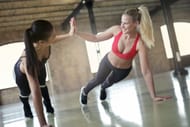Hip dip workouts frequently refer to movements that engage the glutes, abductors, and adductors—muscles that surround the hips. Improving the general strength and form of the hip region can be achieved by strengthening these muscles.
The term "hip dip" often describes the natural curve or indentation that can develop between the top of the thigh and the hip bone. It varies from person to person and is a typical anatomical feature of the body.
Your level of health has nothing to do with hip dips. Some people's hip bones are situated above the femur. An indentation on the exterior of your lower hip region may result from this. Hip dips can have different looks depending on where the femur is positioned, angled, and rotated.
Hip dip workouts with weights

While one cannot eliminate hip dips, some exercises can reduce them. Below is a list of hip dip workouts to try with weights:
1) Weighted hip thrusts
Here's how to do this:
- Position yourself on the ground with your feet flat on the floor, a weight across your hips, and your upper back resting against a bench.
- As you raise your hips towards the ceiling, drive through your heels and squeeze your glutes.
- Repeat after lowering your hips once more.
2) Weighted side plank hip dips
Here's how to do this:
- With your body in a straight line and your elbow exactly beneath your shoulder, begin in the side plank position.
- Put some weight on your hips, bring them down on the floor, and raise them back up.
- Do the same on the other side.
- Repeat for the appropriate number of times.
3) Weighted Bulgarian split squats
Here's how to do this:
- Place one foot up on the bench behind you while facing away from it.
- Hold weights in both hands.
- Maintaining your front knee over your ankle, drop your body into a lunge.
- Push through the front foot's heel to get back to where you were.
- Repeat for the desired number of times.
4) Weighted sumo squats
Here's how to do this:
- Stand with your feet wide apart, pointing your toes slightly outward.
- Hold a dumbbell at your chest.
- Maintain a straight back and chest and lower yourself into a squat.
- Rise back to the starting position.
- Repeat for the desired number of times.
5) Weighted step-ups
Here's how to do this:
- Hold weights at your sides and use a solid bench or box.
- Driving through the heel with one foot, take a step up onto the bench.
- Retrace your steps and switch up your leg movements.
6) Weighted clamshells
Here's how to do this:
- Begin by lying on your side.
- Place a weight on your hips and bend your knees to a 90-degree angle.
- Raise your top knee towards the ceiling and then lower it again while keeping your feet together.
- Repeat for the appropriate number of times.
Always begin with a weight that you are comfortable with while enabling you to use the correct form. You need to target different angles and parts of the hip muscles, so it's important to incorporate a range of exercises into your regimen.
How does adding weights help in hip dip workouts?

Weighted hip dip workouts can provide your muscles with more resistance, making them work harder. There are various advantages to this increased resistance:
1) Muscle activation
Your muscles have to work against more resistance when you use weights, which causes your muscles to contract more. Increased workloads have the potential to promote muscle growth, especially in the adductors, abductors, and glutes.
2) Strength development
Weighted hip dip workouts aid in strengthening specific hip-related muscle groups. Better hip stability and total functional mobility can be attributed to increased strength.
3) Caloric expenditure
Adding weights to the hip dip workouts creates resistance. Resistance training raises the intensity of the exercise and may result in a greater burn of calories. This may be helpful for people looking to control their weight or increase their level of general fitness.
4) Adding variety and challenge
Your hip dip exercises become more fascinating and demanding when you include weights in the practice. Exercise variety and resistance are two other ways to keep your workouts interesting and avoid plateaus.
Remember to increase the weights gradually. To increase flexibility and lower your chance of injury, always warm up before beginning an exercise and cool down afterward.
